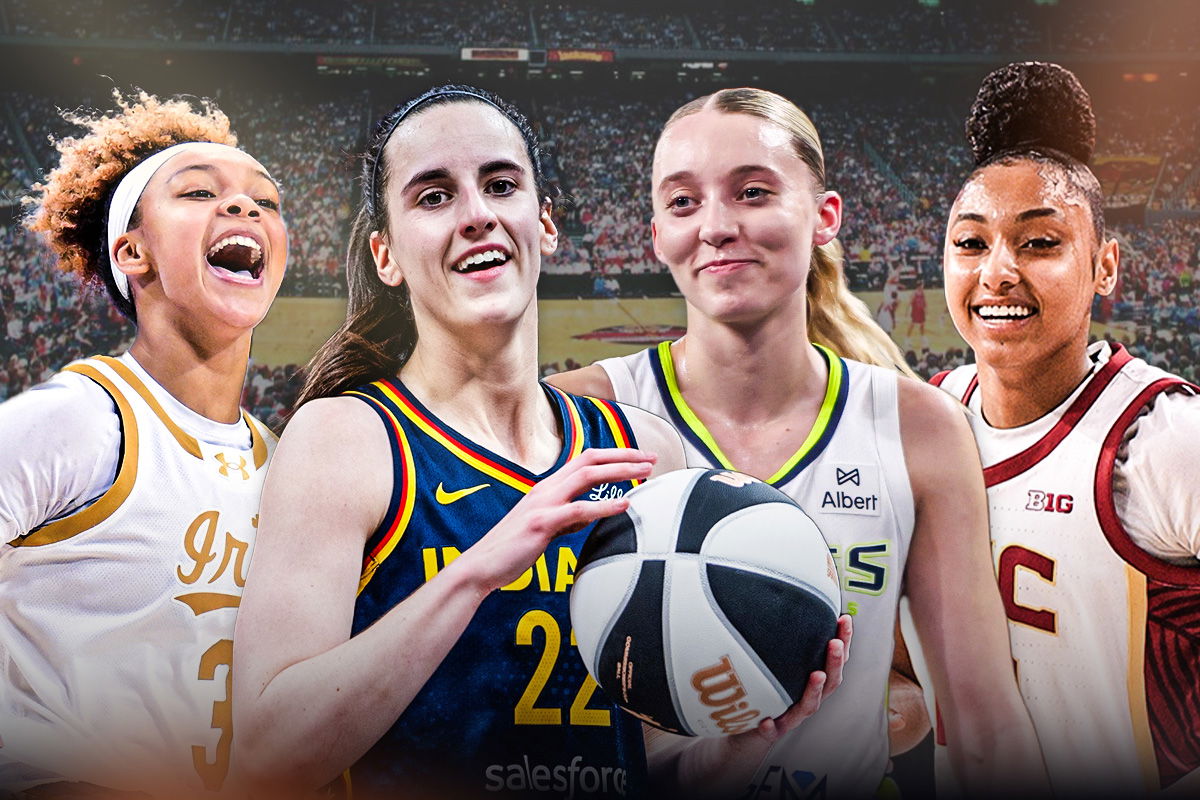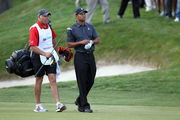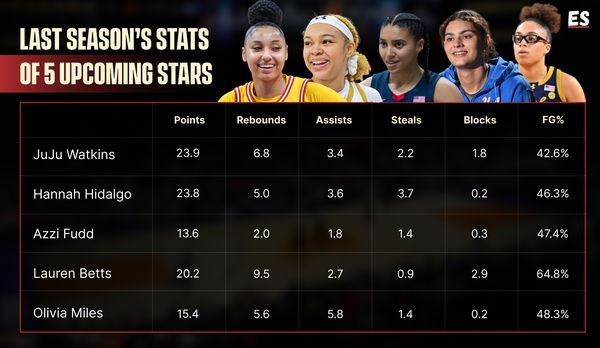
Imago
Credits : Imagn

Imago
Credits : Imagn
“It was a risk that, if things didn’t work out, it could have been a hit.” Those were David Stern’s words, yet the WNBA launched with ambition and energy. The inaugural game between the Liberty and the Sparks drew 5.04 million viewers—a record that still stands today. Expansion followed rapidly, growing from 8 teams in the first season to 16 by 2002. But rapid growth had a price.
The league was booming, yet the foundation was still finding its footing.
By 2010, the WNBA had contracted back to 12 teams. The talent gap was simply too wide. This isn’t about comparing men’s and women’s sports—it’s about the league’s reality: there weren’t yet enough elite players to populate every franchise with top-tier talent, and sustaining competitive balance required consolidation.
ADVERTISEMENT
Article continues below this ad
To be fair, the WNBA has never truly faced a “talent drought.” The foundation era boasted legends like Cynthia Cooper, Lisa Leslie, and Sheryl Swoopes. The middle years were defined by powerhouse stars such as Lauren Jackson, Candace Parker, and Diana Taurasi. Today, the modern era belongs to A’ja Wilson and Breanna Stewart. The league has always produced superstars—what it lacked at times was the depth to have them all shining simultaneously. But more than that, one reason kept pulling them back.
The rookies stepping in often weren’t ready for the pace and intensity of the WNBA. Year after year, the talent pipeline seemed thin, and fan engagement dipped as a result. Fast forward to today, and the story has changed—ratings are on the rise, arenas are filling up, and the league’s momentum is back in full swing.
ADVERTISEMENT
Article continues below this ad
Caitlin Clark’s arrival has changed the game. But for good, the popularity hasn’t been limited to just Caitlin Clark.
Top Stories
Tiger Woods’ Treatment of Caddies Set Him Apart from PGA Tour Rivals, Confesses Steve Williams

Shedeur Sanders Announces What’s Next ‘After’ Landing Browns’ Starting Role Over Dillon Gabriel

Rickie Fowler Comes Clean on Health Issue Stopping Him from Playing PGA Tour Events

NFL Makes Final Punishment Decision on Frankie Luvu After Suspending Commanders LB

Jets GM Confirms Why They Rejected Andy Reid & Chiefs’ Bid For Breece Hall on Deadline Day

Sydney McLaughlin-Levrone Makes a Firm Admission After Being Part of New York City Marathon for Special Cause

| More than 54 million viewers tuned into the 2024 regular season across ABC, CBS, ESPN, ESPN2, ION, and NBA TV. |
| In-arena attendance skyrocketed too, hitting 2.4 million fans—the league’s highest mark in 22 years and a staggering 48% jump from previous seasons. |
Despite Clark playing just 13 games this season, the WNBA still set a new attendance record. Across 226 games, 13 teams drew a combined 2,501,609 fans, breaking the all-time attendance record that had stood since 2002. And this number will only rise as the season progresses. The answer behind the rise is simple. The WNBA is finally producing more talented players across the board. But how?
ADVERTISEMENT
Article continues below this ad
Inside the WNBA’s Growing Talent Pipeline
Today’s WNBA rookies are sharper, more prepared, and ready to compete from day one. “I think there are just so many more uh opportunities available for young players to grow their games and develop their games that didn’t exist, you know, 10 even like a generation ago,” said Sabreena Merchant—and she’s spot on. Enhanced development pipelines, elite college programs, and overseas experience are producing players who can hit the ground running. But WNBA Commissioner Cathy Engelbert has one more point.
Technology has amplified that growth. Engelbert, “technology continues to fundamentally change the sports landscape.”
The rise of data analytics in the WNBA since 2010 has been one of the biggest game-changers. Coaches and executives crave every edge they can get, and nothing fuels that more than fresh insights pulled straight from the numbers. A huge driver of this shift has been Synergy Sports.
|
And it’s not just the pros—Synergy has been powering college teams too, creating a full pipeline of players entering the league with a deeper understanding of the game. Then came the next big leap—optical tracking. Just last year, the league struck a deal with Second Spectrum, giving:
Teams access to 3D tracking data in real time.
Now coaches and analysts can break down everything from shot quality and shooter impact to paint touches, max speed, and even the total distance a player covers in a game. It’s a whole new level of insight, and it’s only making players sharper. Imagine being able to break down A’ja Wilson’s offensive arsenal or study Sabrina Ionescu’s off-ball movement and shooting patterns. That kind of access automatically sharpens your own game.
As Sabreena Merchant explained, “Now you’re at a point where, if you’re Kiki Iriafen entering the league, you’ve already studied players like A’ja Wilson and Alyssa Thomas. You know their games, you know the style of play, and you’re comfortable with what the W is going to look like.” The visibility and accessibility of the league have become a huge advantage, making rookies far more prepared than ever before.
With more games being widely televised and data analyzed by every athlete and organization, player quality was bound to rise. But film and numbers alone don’t get the job done—you’ve got to put in the work too. That’s why so many players today hire personal trainers in the offseason, focusing on sharpening specific parts of their game. Take Angel Reese, for instance.
Reese spent her offseason grinding with Hall of Famer Lisa Leslie, and the results speak for themselves. Her shooting efficiency has jumped from 39.1% to 45.8%, a huge leap in just one year. Michaela Onyenwere took a similar approach, working closely with Seattle Storm’s player development coach, Elijah Knox, to polish her three-point shot and tighten her handle.
And that is exactly why the future of the WNBA looks so bright….
Essentially Sports’ verdict:
Paige Bueckers just became the first player in WNBA history to drop 40+ points on 80% shooting, Sonia Citron set the Mystics’ franchise record for most points, and her rookie teammate Kiki Iriafen grabbed a franchise-best number of rebounds. These aren’t just isolated performances but signs of what’s coming. Every season, the talent pool gets deeper, the rookies look more polished, and the future of the W keeps shining brighter.
The WNBA couldn’t sustain its growth to 16 teams and had to contract to 12 teams. This rise in popularity has already seen them extend to 18 teams by 2030, and it has all been possible due to 3 things.
- Easy accessibility of games
- Use of data and film
- Use of personal trainers
And there’s plenty more talent on the way. As Ensemble founder Ian Schafer put it in an exclusive chat with EssentiallySports’ Chloe V. Mitchell: “You saw with Azzi Fudd, the next generation of talent is coming. Coming fast.”

Take JuJu Watkins, for example. She just made history by breaking Caitlin Clark’s record for most points scored in a player’s first two college seasons. Clark had 1,662 as a freshman and sophomore, but JuJu finished with 1,709, already cementing herself as one of the best scorers in women’s college basketball history.
Then there’s Hannah Hidalgo. She swept the 2025 ACC Player of the Year and Defensive Player of the Year honors, while nearly walking away with the National Player of the Year award, too. And speaking of NPOY, how can we leave out Lauren Betts? The UCLA star anchored the Bruins to their first-ever No. 1 overall seed on Selection Sunday and carried them all the way to their first Final Four. She averaged 20 points and 9.5 rebounds on a ridiculous 64.8% shooting clip, proving herself as one of the most efficient bigs in the country.
And the list doesn’t stop there. Olivia Miles, Flau’jae Johnson, Ta’Niya Latson, Kiki Rice, and Gianna Kneepkens have already proven they can deliver in high-pressure moments. Then you’ve got youngsters like Mikayla Blakes, who casually dropped multiple 50-point games as a freshman, and Tennessee’s Talaysia Cooper, another rising name worth circling for the future.
So yeah, there’s no shortage of talent in the W right now. In fact, you could argue the league is in the best shape it’s ever been when it comes to its talent pool since its very inception back in 1997. All it needs to do is groom and keep them safe. Can they? Only time will tell.
ADVERTISEMENT
ADVERTISEMENT
ADVERTISEMENT
ADVERTISEMENT

